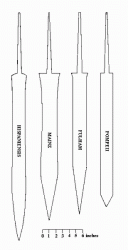OUMoose said:I think that knife defenses and knife disarms are 2 completely different animals. A former instructor once told me "don't look for a disarm, but if it presents itself to you, don't ignore it." Those are pretty wise words. If you hunt for a disarm, attempting to "Defang the snake" as people love to say, you're going to get cut. If in the course of combat an opening appears to you and your instincts say do it, do it!
My guide to knife defense:
Technique #0: Talk your way out! but since everyone knows how to talk, lets move on.
Technique #1: The "Nike" technique - While keeping your awareness on your attacker, take 5 steps backwards. In those 5 steps, rotate your torso and legs approximately 180 degrees, keeping lightly on the balls of your feet. When rotation is complete, firmly plant your lead leg, extend your lead arm and back leg forward in a vigorous motion, causing you to move away at an accelertated pace. Repeat until the attacker is no longer in sight.
Technique #2: "Smokescreening" - whatever small object available to you, pick it up. Dirt, change, a piece of wood, some garbage, etc, all make handy tools. Using an underhand (or sidearm if you feel more comfortable), project those loose objects into the face/eyes of the attacker. Then, refer to technique #1.
If you get to this point and the aggressor is still advancing, the only thing going to help you is actual training, so keep your arms in, tuck your chin, and hope the aggressor doesn't know what he/she is doing!
I agree with those wise words
As to item #0. Some can talk better than others.
#1, this is really good. I am being 100% serious here. He even mentions within sight. This means keeping aware of your opponent. :asian:
#2, This works for anything you find. Including a can of tuna fish.

